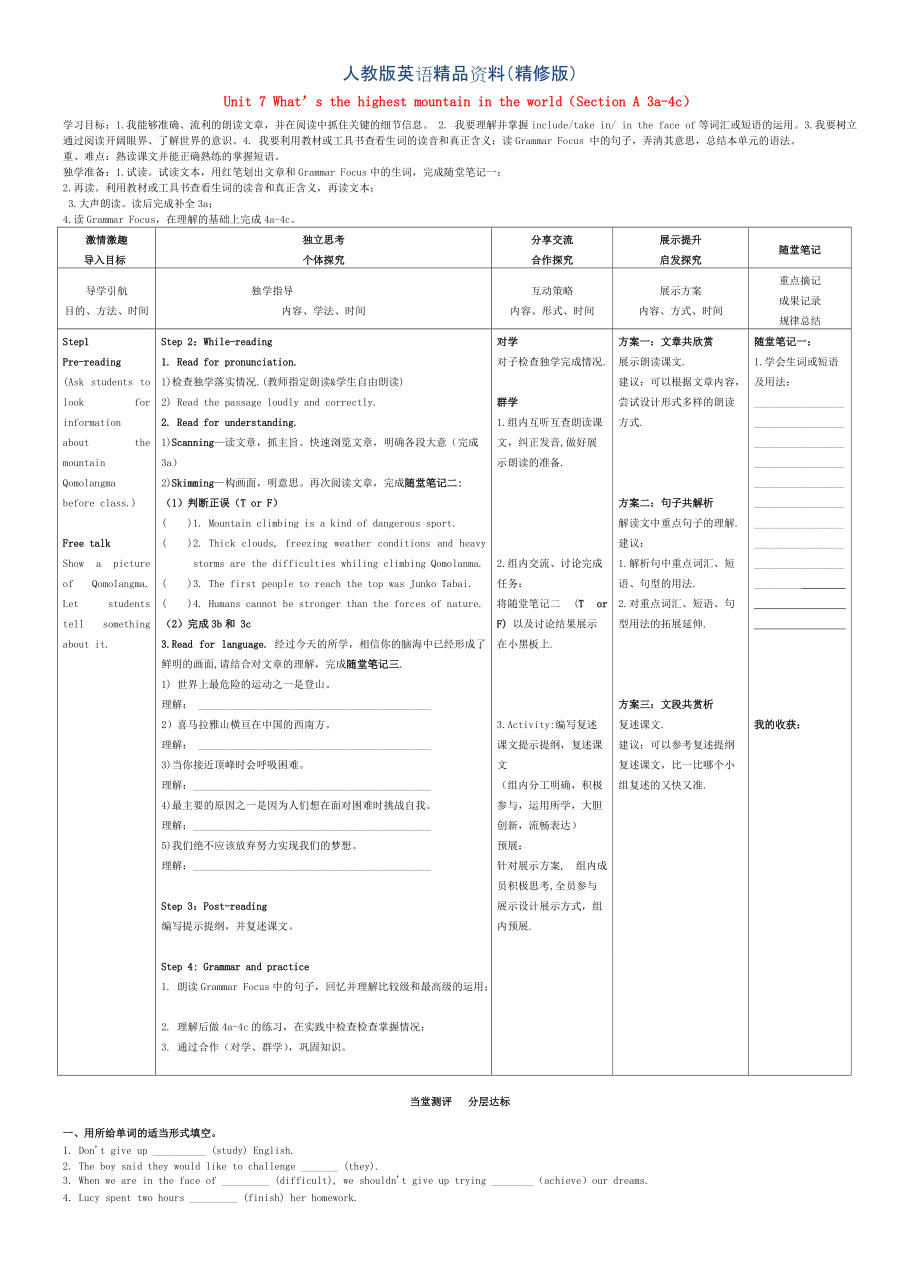《人教版八年級(jí)英語(yǔ)下冊(cè) Unit 7 Section A 3a4c導(dǎo)學(xué)案精修版》由會(huì)員分享�,可在線閱讀,更多相關(guān)《人教版八年級(jí)英語(yǔ)下冊(cè) Unit 7 Section A 3a4c導(dǎo)學(xué)案精修版(2頁(yè)珍藏版)》請(qǐng)?jiān)谘b配圖網(wǎng)上搜索���。
1�、人教版英語(yǔ)精品資料(精修版)
Unit 7 What’s the highest mountain in the world(Section A 3a-4c)
學(xué)習(xí)目標(biāo):1.我能夠準(zhǔn)確����、流利的朗讀文章,并在閱讀中抓住關(guān)鍵的細(xì)節(jié)信息����。?2. 我要理解并掌握include/take in/ in the face of等詞匯或短語(yǔ)的運(yùn)用。3.我要樹(shù)立通過(guò)閱讀開(kāi)闊眼界��、了解世界的意識(shí)��。4. 我要利用教材或工具書(shū)查看生詞的讀音和真正含義����;讀Grammar Focus 中的句子,弄清其意思����,總結(jié)本單元的語(yǔ)法�����。
重�����、難點(diǎn):熟讀課文并能正確熟練的掌握短語(yǔ)�����。
獨(dú)學(xué)準(zhǔn)備:1.試讀��。試讀文本���,用紅筆劃出文
2�、章和Grammar Focus中的生詞,完成隨堂筆記一�;?
2.再讀。利用教材或工具書(shū)查看生詞的讀音和真正含義���,再讀文本���;
?3.大聲朗讀����。讀后完成補(bǔ)全3a�;
4.讀Grammar Focus,在理解的基礎(chǔ)上完成4a-4c�。
激情激趣
導(dǎo)入目標(biāo)
獨(dú)立思考
個(gè)體探究
分享交流
合作探究
展示提升
啟發(fā)探究
隨堂筆記
導(dǎo)學(xué)引航
目的、方法����、時(shí)間
獨(dú)學(xué)指導(dǎo)
內(nèi)容、學(xué)法���、時(shí)間
互動(dòng)策略
內(nèi)容���、形式、時(shí)間
展示方案
內(nèi)容�、方式、時(shí)間
重點(diǎn)摘記
成果記錄
規(guī)律總結(jié)
Step1
Pre-reading?
(Ask students
3�、to look for information about the mountain Qomolangma before class.)
Free talk
Show a picture of Qomolangma. Let students tell something about it.
Step 2:While-reading
1. Read for pronunciation.
1)檢查獨(dú)學(xué)落實(shí)情況.(教師指定朗讀&學(xué)生自由朗讀)
2) Read the passage loudly and correctly
4、.
2. Read for understanding.
1)Scanning—讀文章��,抓主旨��。快速瀏覽文章��,明確各段大意(完成3a)
2)Skimming—構(gòu)畫(huà)面���,明意思����。再次閱讀文章��,完成隨堂筆記二:
(1)判斷正誤(T or F)
(????)1. Mountain climbing is a kind of dangerous sport.
(????)2.?Thick clouds, freezing weather conditions and heavy storms are the difficulties whiling climbing Qomolanma.
5���、(????)3.?The first people to reach the top was Junko Tabai.
(????)4. Humans cannot be stronger than the forces of nature.
(2)完成3b和 3c
3.Read for language.?經(jīng)過(guò)今天的所學(xué)����,相信你的腦海中已經(jīng)形成了鮮明的畫(huà)面,請(qǐng)結(jié)合對(duì)文章的理解����,完成隨堂筆記三.
1)?世界上最危險(xiǎn)的運(yùn)動(dòng)之一是登山。
理解: ____________________________________________
2)喜馬拉雅山橫亙?cè)谥袊?guó)的西南方���。
理解: __
6、__________________________________________
3)當(dāng)你接近頂峰時(shí)會(huì)呼吸困難�。
理解:_____________________________________________
4)最主要的原因之一是因?yàn)槿藗兿朐诿鎸?duì)困難時(shí)挑戰(zhàn)自我。
理解:_____________________________________________
5)我們絕不應(yīng)該放棄努力實(shí)現(xiàn)我們的夢(mèng)想��。?
理解:_____________________________________________
?????????????????????????????
Step 3
7、:Post-reading
編寫(xiě)提示提綱�,并復(fù)述課文。
?
Step 4: Grammar and practice
1. 朗讀Grammar Focus中的句子�,回憶并理解比較級(jí)和最高級(jí)的運(yùn)用;
2. 理解后做4a-4c的練習(xí)���,在實(shí)踐中檢查檢查掌握情況���;
3. 通過(guò)合作(對(duì)學(xué)、群學(xué))�����,鞏固知識(shí)����。
對(duì)學(xué)
對(duì)子檢查獨(dú)學(xué)完成情況.
群學(xué)
1.組內(nèi)互聽(tīng)互查朗讀課文,糾正發(fā)音,做好展示朗讀的準(zhǔn)備.
2.組內(nèi)交流�����、討論完成任務(wù):
將隨堂筆記二 (T or F)?以及討論結(jié)果展示在小黑板上.
3.Activity:編寫(xiě)復(fù)述課文提示提綱�����,復(fù)述課文
8、(組內(nèi)分工明確��,積極參與�,運(yùn)用所學(xué),大膽創(chuàng)新�,流暢表達(dá))
預(yù)展:
針對(duì)展示方案, 組內(nèi)成員積極思考,全員參與展示設(shè)計(jì)展示方式,組內(nèi)預(yù)展.
?
方案一:文章共欣賞
展示朗讀課文.
建議:可以根據(jù)文章內(nèi)容�,嘗試設(shè)計(jì)形式多樣的朗讀方式.
方案二:句子共解析
解讀文中重點(diǎn)句子的理解.
建議:
1.解析句中重點(diǎn)詞匯、短語(yǔ)����、句型的用法.
2.對(duì)重點(diǎn)詞匯、短語(yǔ)����、句型用法的拓展延伸.
方案三:文段共賞析
復(fù)述課文.
建議:可以參考復(fù)述提綱復(fù)述課文,比一比哪個(gè)小組復(fù)述的又快又準(zhǔn).
隨堂筆記一:
1.學(xué)會(huì)生詞或短語(yǔ)及用法:
__
9�����、________________________________________________________________________________________________________________________________________________________________
我的收獲:
當(dāng)堂測(cè)評(píng) 分層達(dá)標(biāo)
一�����、用
10���、所給單詞的適當(dāng)形式填空��。
1. Don't?give?up?__________ (study)?English.?
2. The?boy?said?they?would?like?to?challenge?_______?(they).
3. When?we?are?in?the?face?of?_________?(difficult),?we?shouldn't?give?up?trying ________(achieve)our?dreams.
4.?Lucy?spent?two?hours?_________?(finish)?her?homework.
5. Haina
11��、n is a very large Island .It is the second _________ (large) island in china.
6. Our teacher is as ________ (busy) as before.
7. He is ______________ (careful) among us.
8. Li Lei jumped ______ (far) than Jim.
9. The busier he is, the ________ (happy) he feels.
二����、完成句子���。
1. The Yangtze Riv
12��、er is______________________ (第三長(zhǎng)河)in the world.
2. The Atlantic is _______________________ ( 第二大洋)in the world.
3. Lin Tao is __________________________ (最懶的學(xué)生之一)in the class because he never gets to school on time.
4. Edison was_________________________(最偉大的發(fā)明家之一)in the world.
三
13����、���、句型轉(zhuǎn)換���。
1. Flat A is more expensive than Flat B
Flat B is _____ __________ than Flat A.
Flat B is ________ _______ Flat A.
Flat B is not ______ _______ ______ Flat A.
2. I prefer math to English.
I like math ________ ________ English.
3. He is the tallest student in the class.
He is ________ _________ ________ ________ _________ in the class.
 人教版八年級(jí)英語(yǔ)下冊(cè) Unit 7 Section A 3a4c導(dǎo)學(xué)案精修版
人教版八年級(jí)英語(yǔ)下冊(cè) Unit 7 Section A 3a4c導(dǎo)學(xué)案精修版

